Expert’s Rating
Pros
- Dazzling display
- 67W fast charging
- Great performance for the price
Cons
- F3 offers better bang for buck
- Battery life not as long as rivals
- Generic design
Our Verdict
The Poco F4 fulfills its promise to be a great mid-range phone. The trouble is, it’s barely any different to the F3, despite costing more. That makes it very difficult to recommend.
Poco released the F4 GT back in spring of this year – a gaming phone with some top specs and a bold design. Now it’s being joined by the standard Poco F4, a more understated phone, but one that is also more affordable and ideal for someone looking for an all-round, good-value device.
I’ve used the Poco F4 to see how it copes day to day, find out how good the cameras are, how the design holds up and more.
Design & Build
- Sleek but generic design
- IP53 rating
- No headphone jack
The Poco F4 is available in a choice of three colours: black, silver and green. Although the design isn’t garish like the GT (or some other older Poco models), it’s almost so plain that it doesn’t really stand out from the crowd. Currently, Poco phones lack a distinctive design language, and it really shows with the F4.
At 7.7mm it is rather slim, and also quite lightweight at 195g. Despite the thin build, it feels sturdy and the IP53 rating will guard against some dust and light rain. The presence of any sort of waterproofing on a phone at this price makes the F4 competitive against rivals such as the Realme 9 Pro+.
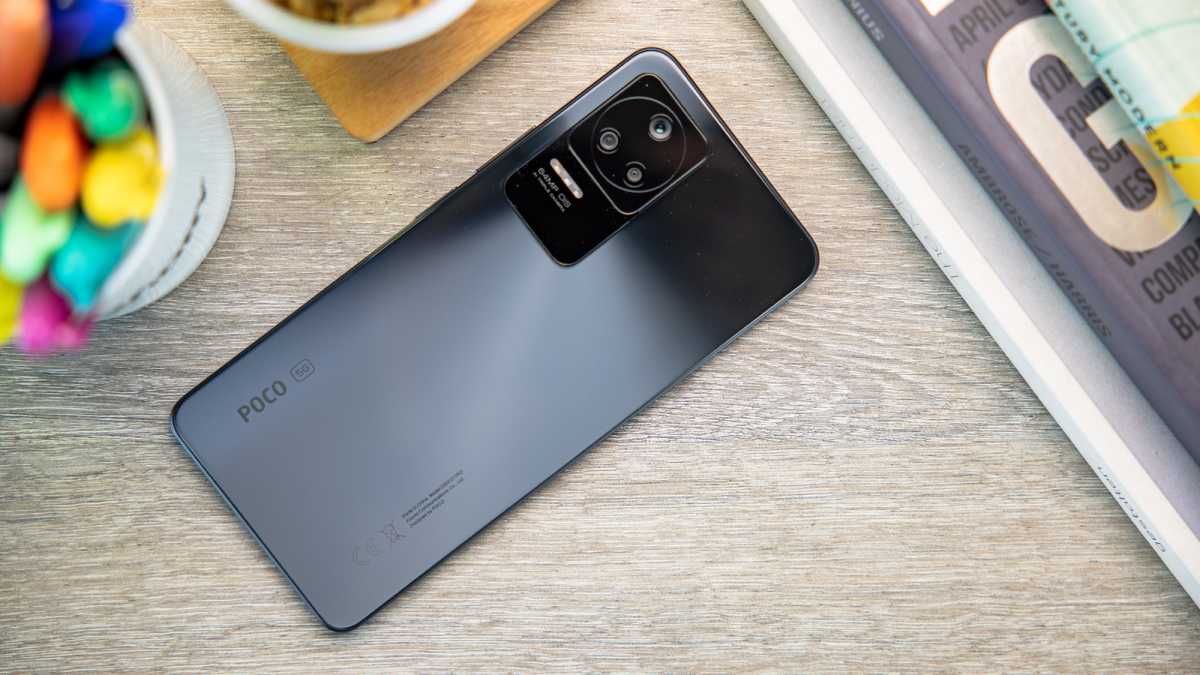
Dominik Tomaszewski / Foundry
Like the GT variant, the Poco F4 doesn’t have a headphone jack – which may be a deal-breaker for some (but likely not many in this age of Bluetooth headphones). There’s a side-mounted fingerprint scanner on the power button, and I found this worked successfully.
The Poco F4 has a seven-layer heat dissipation structure and a vapour chamber cooling system, all designed to keep the chip cool when running strenuous tasks. However, the phone itself still gets pretty hot when you’re gaming.
Screen & Speakers
- 120Hz refresh rate
- Stereo speakers
- Variable refresh rate
One of the best things about the Poco F4 is its 6.67in FHD+ AMOLED display, which boasts a 120Hz refresh rate and support for Dolby Vision. This phone has a different panel to the F3, which Xiaomi claims makes colours appear brighter, improves visibility and HDR performance.
I wasn’t able to compare the F4 directly to the F3, but I can say that videos do look great, as do images on this screen. Brightness is enough that I could use it under direct sunlight and not feel like there was a huge amount of glare. I also didn’t need to set it to full brightness all the time.

Dominik Tomaszewski / Foundry
This phone has a variable refresh rate display, which means that it can switch between 60Hz and 120Hz depending on the task you’re doing. This means smooth scrolling in social media feeds, but a lower refresh rate at other times to conserve battery power. Alternatively, you can keep it locked to one or other the whole time.
The F4 has stereo speakers which support Dolby Atmos. The audio that fires from both ends of the phone is loud and punchy, and even music has clarity and depth, if not much bass.
Specs & Performance
- Up to 8GB RAM + 256GB storage
- Qualcomm Snapdragon 870 processor
- Decent daily performance
The Poco F4 uses a Snapdragon 870 processor. It’s not quite the newest chip on the block, but it does deliver smooth performance and is very capable of multitasking without a hitch. It can even run some games like Genshin Impact on lower settings, though this demanding game does become a bit laggy when graphics are set to medium.
You can see how the F4 compares to the F4 GT and other Android phones in our benchmarking tests:
So, performance is fine, but there’s a problem: it’s exactly the same as the Poco F3, so there’s absolutely no reason to upgrade if you already own that phone.
You can read our interview with Poco’s global head, who puts this decision down to Qualcomm not releasing a new affordable chip that is a worthy successor to the Snapdragon 870.
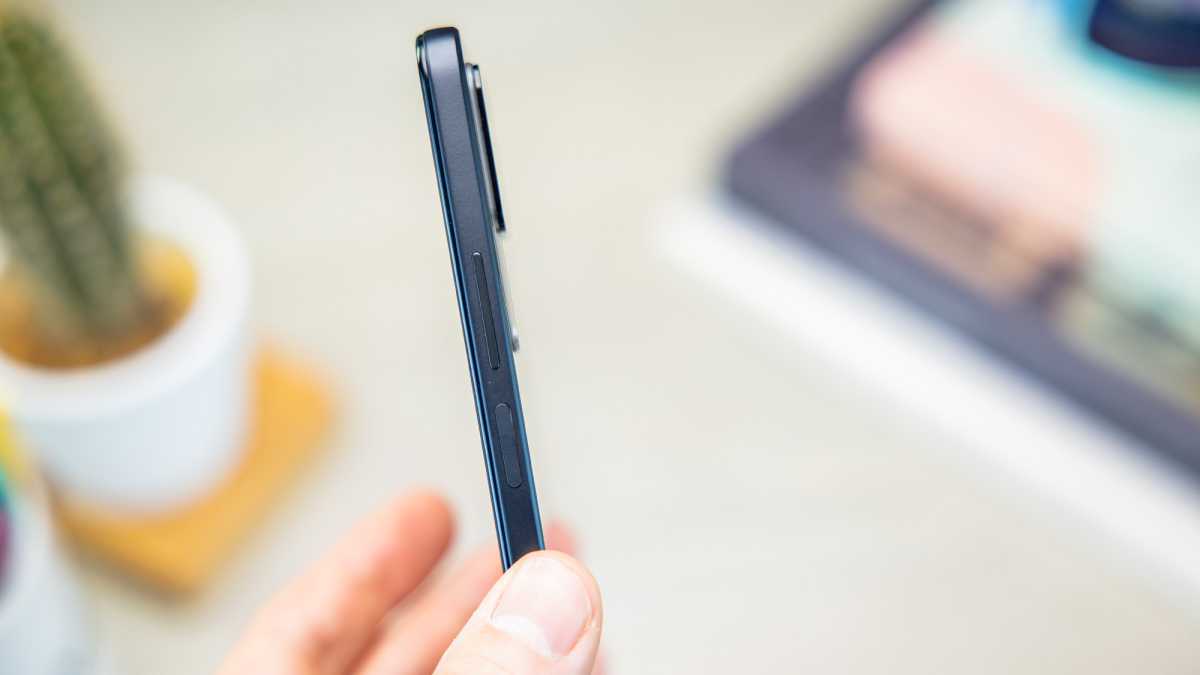
Dominik Tomaszewski / Foundry
Cameras
- 64Mp main camera with OIS
- Mixed night mode
- Video up to 4K at 60fps
The Poco F4 has a triple-camera system: a 64Mp with OIS, an 8Mp wide-angle and a 2Mp macro.
You can easily capture a decent photo during the day, with sharp details and distinctive textures. Like other mid-rangers, the HDR mode on this phone is on the strong side, making shades appear extremely vivid but slightly unnatural. The camera can also suffer from flare from the sun on bright days.
The addition of OIS is the biggest change from the Poco F3. Photos taken in low-light still look good, and have decent colours. However, the F4 does struggle at night when there are bright lights in the frame. Overall, the results aren’t quite as impressive as from other mid-range phones.
On moving subjects, the OIS does help stabilise subjects and reduce motion blur in places, but this is inconsistent.
Portrait mode has sufficient background blur but loses the sharpness and detail – especially in low lights. Wide-angle shots from the 8Mp lens lose the clarity and sharpness of shots from the main camera, and colours aren’t as vivid. However, it is still handy for landscape shots or group photos.
Like most affordable mid-range phones, the macro camera is far from impressive. In fact, it is a 3Mp downgrade on the 5Mp macro camera in the F3.
You can record video up to 4K at 60fps. The built-in microphones pick up audio well, and the footage itself is nice and crisp, with bright, vibrant colours. You can also take advantage of stabilisation to smooth out shaky hands or movement while walking, but this is only available in 1080p at 30fps.
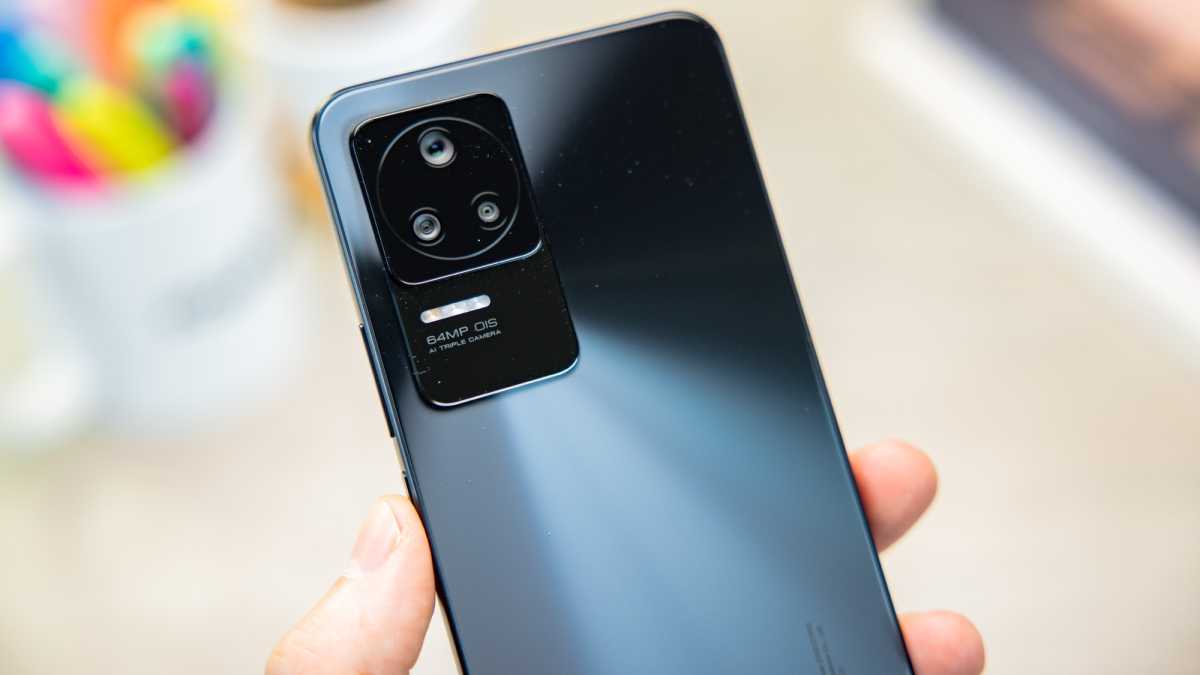
Dominik Tomaszewski / Foundry
Around the front, in the centre of the screen (at the top, that is) is a punch-hole 20Mp selfie camera, which again is a bit of a mixed bag. Whilst colours are fine, some textures such as wisps of hair can get lost in the background blur when using portrait mode. Not a huge surprise: most phones which apply this blurring effect using software suffer the same issues.
Battery Life & Charging
- 67W fast charging
- Just over a day’s battery life
- No wireless charging
Like the F3, the Poco F4’s battery life isn’t worth shouting about. The F4 uses a 4500mAh cell, and the battery struggled to power the phone through an entire day when set to the max refresh rate, playing plenty of games and using it out and about with 5G.
This is also reflected in our benchmarks, where the phone managed 8 hours and 26 minutes – way below the F4 GT and F3. The phone can last longer if you use it conservatively and take advantage of the variable refresh rate and battery saver modes, though.
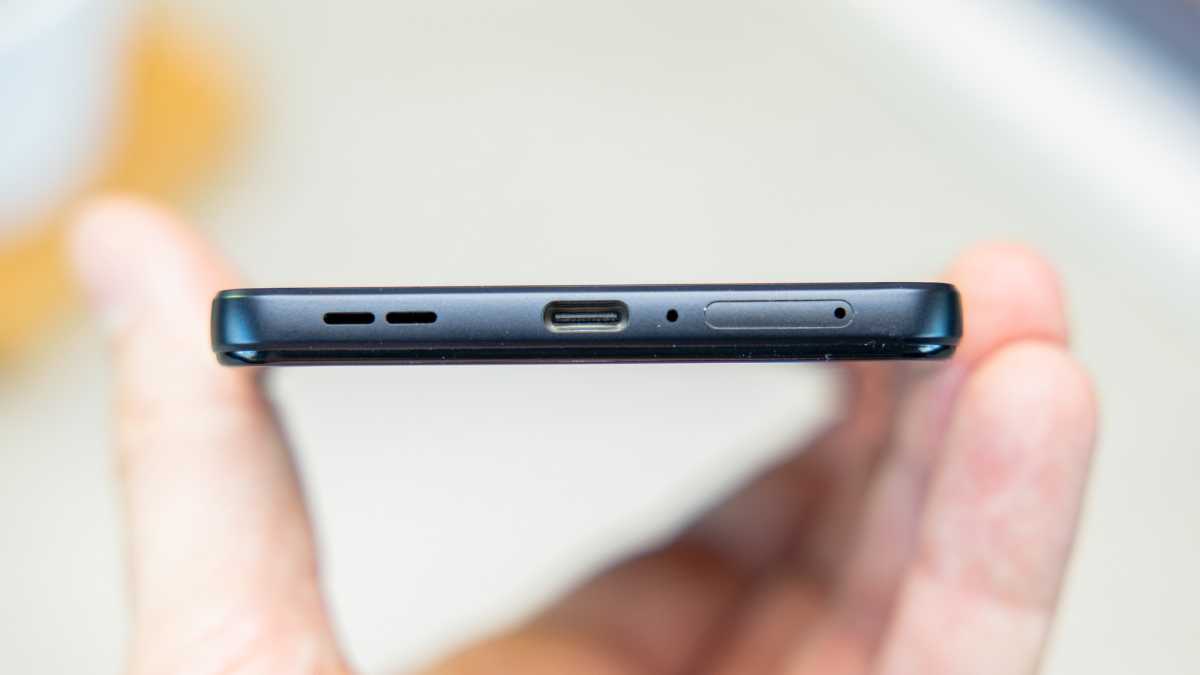
Dominik Tomaszewski / Foundry
The 67W fast-charging tech does exactly what you need it to – recharging the battery to 85% in 30 minutes flat. It’s not the fastest charging we’ve seen, but it’s plenty quick enough that even a five-minute charge will still do enough to give you a few more hours of use out of the phone.
The phone becomes quite hot when charging, as does the charger itself.
Software
- App bloat on MIUI 13
- Based on Android 12
The Poco F4 runs MIUI 13, Xioami’s skin on top of Android 12. Poco hasn’t yet confirmed when it will deliver an Android update, or how many years of security updates it will get. We do know that the F3 took around five months to get the latest OS update after launching.
Xiaomi has always been guilty of stuffing in too many uninstallable apps on its software, and the Poco F4 is no exception. The worst offender is the Poco store app, a storefront that sells only Poco phones (probably not very useful if you’ve just bought the F4), and one Poco wearable device.

Dominik Tomaszewski / Foundry
Swiping downwards on the right-hand side brings up the control centre, while the same motion on the left pulls up the list of notifications. Personally, I prefer the traditional Android setup where the two are packaged together for quicker access.
It’s not all negative of course – the OS takes full advantage of the dazzling display by offering different settings for the panel such as Vivid, Saturated and Original. The colours on the display can also be change to adapt to ambient light or have a specific shade tint from a colour wheel.
All in all, MIUI is not the cleanest skin of Android out there, and regular Google users will notice some glaring differences between the layout of this phone and a device with stock Android.
Price & Availability
Prices for the Poco F4 start from £379/€399/₹32,999 for the 6GB RAM and 128GB storage model, but you can go for the 8GB / 256GB model for £429/€449. In India, the top model gets 12GB of RAM and 256GB of storage and costs ₹39,999.
You can buy it from the Poco store and Amazon – the former had a sale on at the time of review and included a free Poco Watch. Amazon had knocked £20 off Poco’s recommended price. As I write this, it wasn’t possible to get the Poco F4 on a monthly contract.
Like other phones from Poco, the F4 isn’t available in the US – but American readers can import it from sites such as Aliexpress.
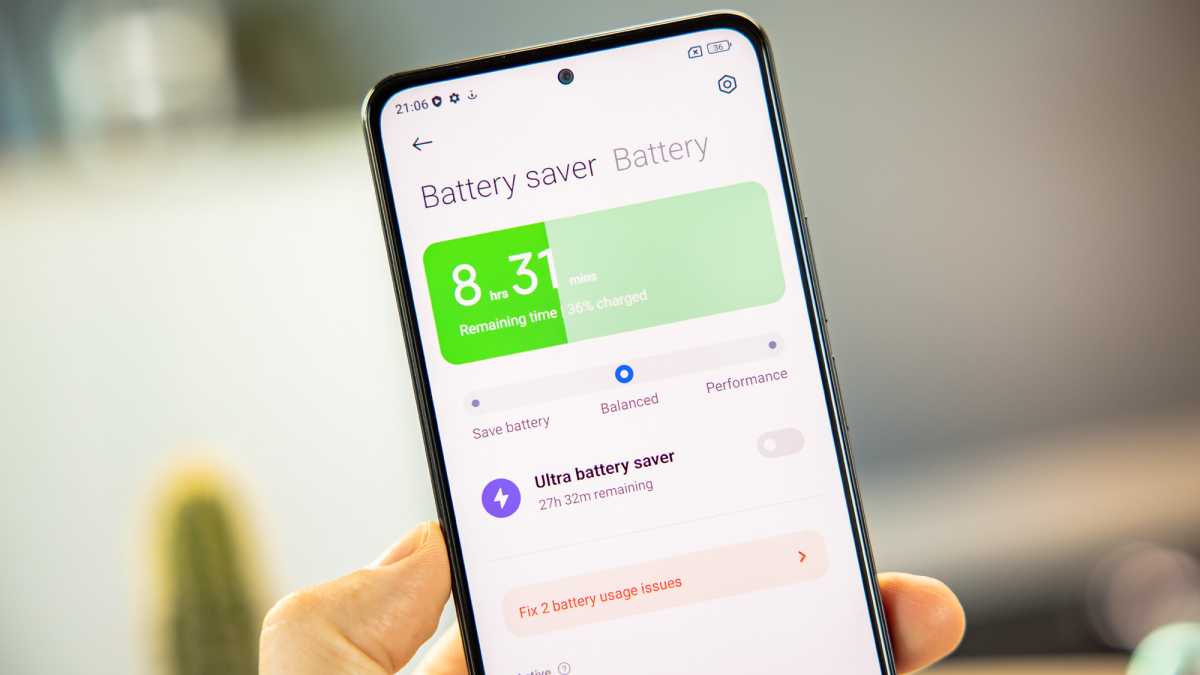
Dominik Tomaszewski / Foundry
For the price, the Poco phone offers a lot. The performance rivals some more expensive mid-range handsets, and the screen is great for watching videos on.
The F4 has a £50/€50 price hike from the F3, which offers a very similar experience for a more affordable price – so it’s hard to justify spending more on the F4 just for the addition of OIS and fast-charging. For a similar price we’d also recommend the Google Pixel 6a and the OnePlus Nord 2T.
You can see how rivals compare in our list of the best mid-range phones, and the best Xiaomi phones – the parent brand of Poco.
Verdict
The Poco F4 follows up on the F3’s legacy by being a great mid-range all-rounder. It’s benefits from a level of water resistance, has an impressive AMOLED display, speedy charging and (despite no upgrade) impressive performance that’s more than adequate, even if you want to play some games.
The cameras aren’t the best you’ll find for the price, and – as mentioned – it’s pretty hard to justify the price hike when there’s very little difference in the new phone.
It might still be a solid mid-ranger, but you’d be better off buying the F3 for less than spending extra on the F4.
Specs
- Android 12 with MIUI 13
- 6.67in Full HD+ (1080×2400) 20:9 AMOLED, 120Hz
- Corning Gorilla Glass 5 display
- Qualcomm Snapdragon 870 processor
- 6/8/12GB RAM
- 128/256GB internal storage
- 64Mp, f/1.79, main camera with OIS
- 8Mp, f/2.2 ultrawide
- 2Mp, f/2.4 macro
- 20Mp, f/2.45 selfie camera
- Video up to 4K @60fps
- Fingerprint scanner (in power button)
- Wi-Fi 6
- Bluetooth 5.2
- GPS
- NFC
- 5G
- Dual Nano SIM
- USB-C
- IP53
- Stereo speakers
- 4500mAh non-removable battery
- Fast charging 67W
- 163.2 x 75.95 x 7.7 mm
- 195g




